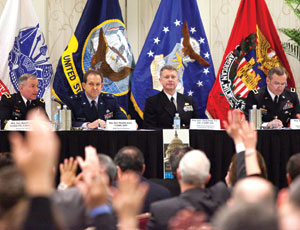Firms looking to boost sagging bottom lines and gain more-robust public-sector construction markets generated a record attendance of more than 550 at this year�s federal and military workload briefings, sponsored by the Society of American Military Engineers on March 18 in Alexandria, Va. Traditional pockets of �milcon� work�such as in base closure and housing�are winding down, officials said. But overseas expansion and new initiatives in energy conservation and facility �quality of life� upgrades are boosting work for the short term, just as new conference attendees were boosting their profiles.

The SAME event preceded by one day testimony from Defense Undersecretary Robert F. Hale, who noted DOD’s $18.7-billion milcon request for fiscal 2011. He said it was down 20% from the previous year, due to $5.2 billion less requested for base realignment and closure, a program set to end in fiscal 2011. But excluding that, he said, the request is up 8.4%. “We’re in a growth industry inside the gates, even though there is a recession outside,” said Brig. Gen. Al T. Aycock, deputy commander of the Army Installation Management Command.
The Army has 700 projects worth $15.7 billion to execute this fiscal year, said Robert Slockbower, military programs director for the Corps of Engineers. Robert Silver, Naval Facilities Engineering Command director of military construction, noted that its FY11 milcon budget of $3.9 billion is “a historic high.” But he noted that recent “robust” budgets will level off. “We’re running on the red line now, but this will trail off to more normal levels,” Silver said.
For now, however, the Navy is gearing up a multibillion-dollar building program on the island of Guam to accommodate the planned transfer of thousands of Marines and others from Okinawa, as a result of a treaty with Japan. But its speed and breadth may depend on how the administration responds to concern over the buildup’s impact on the island’s fragile environment and strained infrastructure. The Navy spent $50 million to study the impacts, but negative reaction to its conclusions from U.S. environmental regulators and others may require White House mediation. President Obama was set to visit Guam on an Asian trip cancelled by last week’s passage of health-care reform.
Military officials cited statistics of expedited procurement and the hiring or rehiring of thousands of contract specialists. They also said the services would continue to embrace design standardization, adding that more joint basing would improve the processes. But executives say there are still major discrepancies in project delivery approaches among the services and that strategies such as “adapt-build” are not uniformly favored by base commanders.

Post a comment to this article
Report Abusive Comment